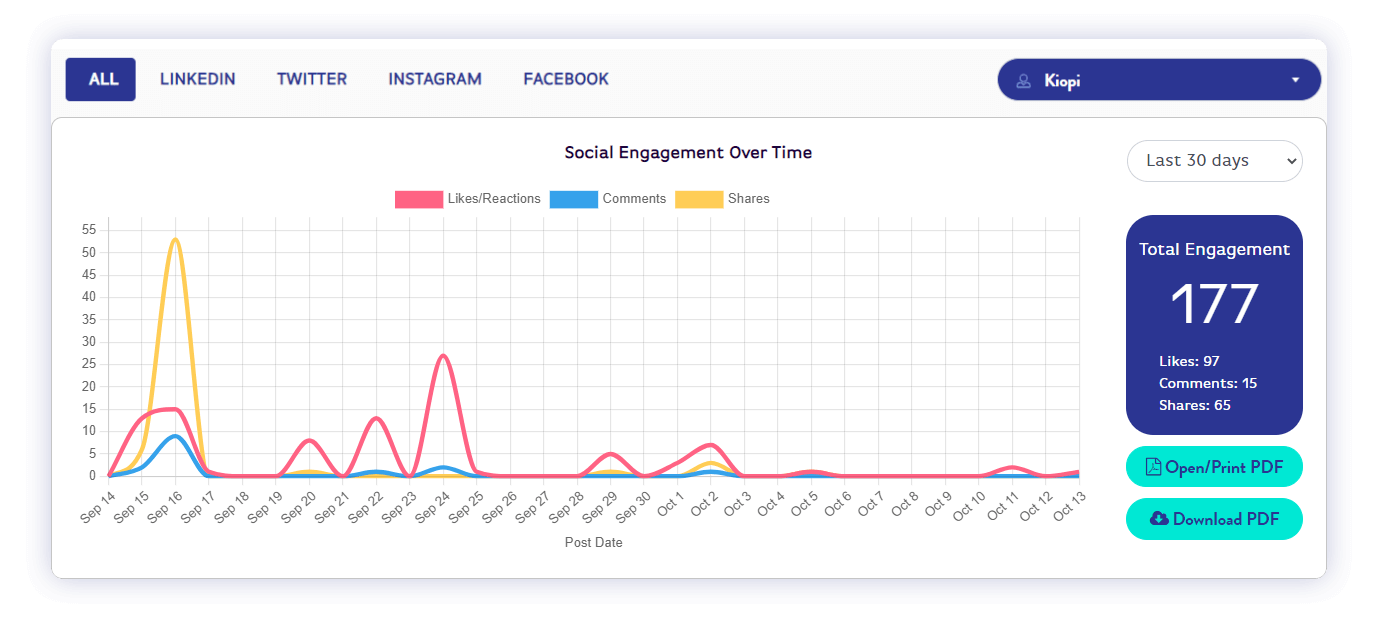Follow the Data
Simply basing your successes or failures on the number of likes or followers you’ve obtained isn’t the best route when it comes to analyzing your social media strategy. Though these numbers can be very telling, they are not the only data you should be measuring. Rather, the best way to gauge your social media presence is to implement a social media analytics tool.
Social media analytics can be incredibly beneficial in determining which of your social media strategies and campaigns are working for you and which ones aren’t quite hitting the mark. It can also give you much more meaningful insights and perform a more thorough performance analysis than what you are able to see from the front end.
Not only can this help improve your marketing efforts in the future, but it can also help save you time, effort, and money along the way.

What is Social Media Analytics?
The ability to acquire and make sense of data gathered from social media platforms to support business choices — and assess the success of actions based on those decisions — is known as social media analytics. It is the process of tracking, recording, and evaluating data from any given social network or platform.
Businesses, marketers, and individuals alike can all benefit from a social analytics tool that allows them to better understand social media performance, track important metrics, and generate effective data reports.
Depending on the insights you’re searching for, the breadth of your social media analysis can be as limited or as broad as you need it to be. Kiopi offers the ability to monitor social media traffic using a variety of social media measuring tools. Detailed reports of likes, reactions, comments, and shares may all be obtained from the metrics gathered by social media analytics, but our social media posting service doesn’t stop there.
The notion of what we call “social listening” is also included in social media analytics. This entails keeping an eye on social media for possible issues as well as opportunities to expand through comprehensive reporting.

What Makes Social Media Analytics Important?
Aside from the obvious benefit of social network performance data being compiled into one easy-to-read report, there are several other reasons why social media analytics tools are so important. For example, these tools can be efficient in:
Spotting trends related to social media campaigns and advertisements
Identifying both high and low-value features of a product or service
Gauging your overall reach
Pinpointing important audience demographics
Effectively analyzing consumer response on different social media platforms
Demonstrating your performance over a certain period of time
Not only may these insights be utilized to make technical adjustments, but they can also be used to guide strategic decisions. In turn, a good social media analytics tool can positively impact a variety of business activities.
Facebook Ads
For example, tracking social media analytics can be effective in product development. By analyzing a collection of things like Facebook ads, tweets, and Instagram comments, you can gain a better understanding of your customer’s ever-changing demands and requested features. Additionally, you may uncover trends that help shape the operation of existing products and services and drive the development of new ones. Businesses may utilize this data to better manage inventories and suppliers, cut costs, and make better use of their budget and resources.
Further, social media analytics may be utilized to maintain brand health, improve social media advertising efforts, adjust positioning, and generate new brand characteristics by continuously monitoring positive and negative engagement.
How To Track Social Media Analytics
While certain social analytics tools allow you to view insights across multiple platforms at once, there are ways in which you can view your analytics for individual accounts. In fact, plenty of social media platforms provide an analytics tool for their users. Some, like Instagram, require you to have a business account set up in order to view insights. Others, such as Twitter, allow both businesses and personal accounts alike to access these reports.
Below, we’ll give you a brief rundown of each of the main social media platforms’ analytics tools and how to access them.
Instagram Analytics
Though Instagram does provide analytics, only business or creator accounts may utilize this feature, and only insights for the content posted after becoming a business or creator account will be available.
To view these insights, simply go to your profile and click the Insights button located below the Edit Profile button. The application will give you an overview of the accounts you’ve reached as well as the number of content interactions, profile visits, and website taps, among other things. You can also choose to view insights from a custom time frame, including the last 7 days, 2 weeks, current month, previous month, and the last 3 months of activity.
In addition to an account overview, you can also view insights from any individual post to Instagram. To do this, simply go to the post in question and click the View Insights button directly below the picture. From here, you will be able to see the full number of interactions taken from the post, such as likes, comments, shares, and bookmarks, as well as the number of impressions and accounts reached.


Facebook Analytics
Though Facebook’s standalone analytics tools is no longer available, the platform still allows users to view their Page Insights. When you post to Facebook, like Instagram, these insights provide measurements of your page’s performance, such as how people are reacting to your content. It also provides demographic information about your audience, though this feature is only applicable once data has been accumulated for 100 or more people. Unlike Instagram, however, Facebook allows you to view insights from the past 2 years rather than a maximum of 3 months.
To view your Facebook analytics, simply click Pages in the left menu of your news feed. From there, select your page and click Insights in the left menu.
Twitter Analytics
Twitter analytics have been available for all accounts since 2014, including both business and personal accounts. This built-in data-tracking tool displays information and data regarding your tweets and user activity. It's similar to Facebook and Instagram in that it uses graphs and reports to display key metrics.
To check your Twitter analytics, select the More button that is located in the left side menu of your profile. From there, click the Analytics tab. This will open a home dashboard in a new tab where you can find your report detailing highlights from each month. These highlights include your top tweet, top mention, and top follower of the month.
Additional insights provide metrics for things such as the number of tweets sent, the number of profile visits and mentions received, how many new followers have been accumulated, and the number of impressions your tweets earned. You may also check the number of impressions and engagement rate for one individual tweet rather than an overview of all your tweets.


LinkedIn Analytics
Provided you have the right permissions, meaning you are a page admin or have “analyst” access, you may also view LinkedIn analytics through the platform itself once you post on LinkedIn. LinkedIn offers five different types of page analytics, including follower, visitor, update, employee advocacy, and talent brand analytics. To locate these LinkedIn analytics, follow these simple steps.
If you are on a desktop computer, click the Me icon at the top of your homepage, then under Manage, click Posts & Activity. For mobile users, tap your profile picture, then click View Profile. Scroll to the Activity section and select See All. Next, depending on what you want to analyze, select either the Articles or Posts tab. Finally, click the Analytics icon located below your post or article.
GMB Analytics
Google provides an extensive business performance report for all of its Google My Business (GMB) users. These analytics allow you to monitor specific profile interactions, including:
- Searches
- Unique profile viewers
- Website clicks
- Calls
- Direction requests
- Messages
- Bookings
There are a few ways to check your GMB account’s analytics. To measure your search query performance, locate your GMB profile and select View Profile. From there, click Promote and then Performance. Finally, at the top of the page, select a date range to base your reports on and click Apply.
You may also choose to measure your Google Maps performance. Owners and managers can see how many times their profile or GMB posts have been visited simply by going to their business profile. The number of views from the last 28 days will be displayed on the dashboard. Profile view insights can help you keep track of how popular your company is with existing and future consumers. To learn even more about your business’s Google Maps presence, click the Insights tab.

Free Social Media Analytics Tools
Though there are many methods and tools out there that allow you to analyze your social metrics, we strongly recommend you use Kiopi for your social media analysis needs. First and foremost, Kiopi is a social media management tool that allows users to plan and schedule posts for a number of different clients and accounts far ahead of time.
However, there’s so much more to it than that. Kiopi also has a variety of additional features such as a comprehensive content calendar, unique campaign management tools, a built-in link shortener, a AI social media post generator (sometimes referred to as an AI caption generator) that’s considered one of the top AI tools for social media management, and yes, even a free social media analytics tool!
From Kiopi’s analytics dashboard, you’ll be able to view a full Engagement Analysis Report for each individual client. A visual chart will depict your social engagement over time, including likes and reactions, comments, and shares. Kiopi allows you to view these reports for the past 30 days, 3 months, or 6 months, depending on the time frame you wish to inspect. Additionally, you can choose between viewing analytics from all of your platforms at once (excluding GMB, as analytics are not currently available) or from each platform individually.
Want a physical copy of these reports? No worries! We made it as easy as the click of a button to download, open, and print a PDF copy of your Engagement Analysis Report.

Try Kiopi’s Built-In Social Media Analytics Tool Today!
If you’re looking for the best social media analytics tool, look no further. Try Kiopi’s 14-day free trial so you can get a feel for all of Kiopi’s features, including our easy-to-use data analytics tool. By utilizing social media analytic reports with the help of useful tools like Kiopi, you’re on the right track to growing your social media management skills and improving your career.
